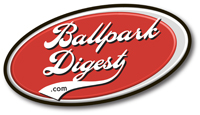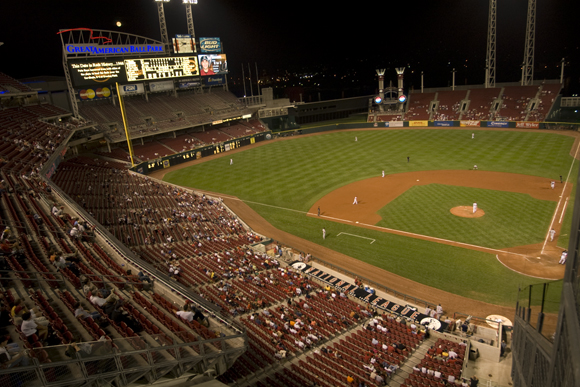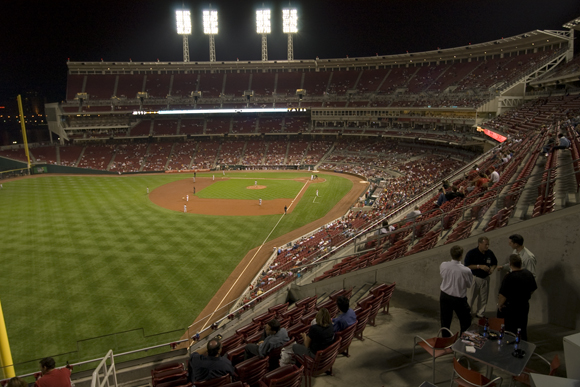Themed ballparks always seem a little gimmicky. That’s why we were a little apprehensive before visiting Great American Ball Park, the home of the Cincinnati Reds. As the home of the first professional baseball team, Cincinnati is a well-known baseball hotbed, and a great area deserves a great ballpark. But the Reds make a big deal about the riverboat theme throughout the ballpark — something that made us a little apprehensive. Is GABP a great ballpark? At times, yes; at times, no. Despite our misgivings about a themed ballpark, in the end the riverboat accouterments didn’t bother us a whole lot.
FAST FACTS
Capacity: 42,059
Architect: Populous, Kansas City
Dimensions: 328L, 379LC, 404C, 370RC, 325R
Website: cincinnati.reds.mlb.com
Phone: 513/765-7000
Ticket Prices (2009): TBA
League: National League
Parking: Plenty of local lots surrounding the ballpark. If you drive to the ballpark, you’ll see plenty of signs pointing you toward parking facilities.
Directions: 100 Joe Nuxhall Way, Cincinnati. Main Street runs parallel to the Ohio River to the south of downtown Cincinnati, and at the ballpark it turns to Joe Nuxhall Way. All the major freeways — I-75, I-71, I-471 — feature easy, well-marked access to the ballpark. From I-75, use the exits at Freeman Avenue and 7th Street; from I-71, use the Gilbert Avenue exit; from I-471, use the 6th Street exit.
The ballpark benefits from a great location and a consistent (though sometimes busy) design. What did bother us, however, was the relatively disjointed nature of the ballpark seating; by breaking up the ballpark into so many disparate elements, you don’t always get the feeling you’re part of a community event. In the end, the disjointed nature of the ballpark kept us from naming Great American Ball Park as one of the best ballparks in the majors, though the many nods to the Reds’ rich history makes it a top-notch facility.
First, let’s address the themed aspects to the ballpark. Cincinnati is a riverfront city — the ballpark, in fact, sits on the shores of the Ohio River and was threatened with flood damage in the winter of 2004 — and as such there are some riverboat elements to the ballpark, particularly in the outfield. Take a look at the picture above: to the left is a building designed to look like the bridge area of a riverboat, and next to it is the front end of a riverboat. They are not purely decorative: the bridge building contains a group area and ballpark workers, while the riverboat is used as a observation deck. In addition, the sponsored steamboat lights up when a Reds player hits a home run. In the end, we really didn’t see the need for both; the steamboat was borderline cheesy and the bridge superfluous. (The steamboat does have one redeeming factor: it contains misters, which can be refreshing on a hot day.)
The sections next to the steamboat comprise the Sun Deck/Moon Deck, which are designed to be evocative of similar bleacher seats at Crosley Field, the team’s former home. (For day games the bleachers were called the Sun Deck; for night games they were called the Moon Deck. Waite Hoyt called those bleachers Burgerville because of the many patrons sipping on a cold Burger Beer.) These are some of the best seats in the house (which we’ll discuss later).
In the greater scheme of things, the riverboat elements really don’t distract too much from what’s right with Great American Ball Park — which is a lot.
First off, there’s an agreeable spaciousness to the ballpark. You can walk around the entire ballpark through a 40-foot-wide concourse, with some strategic areas for viewing the field from the outfield and the gap in the grandstand (again, more on that later). The horseshoe design of the grandstand provides great angles for fans, and our photos are perhaps a bit misleading: in reality, the foul ground isn’t as spacious as these photos would indicate, and the folks sitting in the sections down the lines must constantly be on their guard against foul balls. 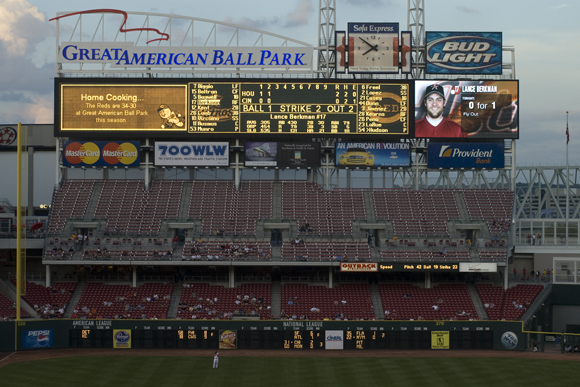
All seats (save the left-field bleacher seats) have a good view of the large outdoor scoreboard. Its most notable feature: an analog clock designed to look like the famous Longines clock in Crosley Field. The scoreboard is large (the fourth-largest in the majors, by our estimates) and comprises three sections focused on fan information (line score, replays, various stats) sitting above advertising. Most MLB scoreboards look like huge ad displays with a little section for fan info; Great American Ball Park bucks that trend. That seems to be keeping with the general practice of minimal ad signage at the ballpark.
Our biggest criticism of the ballpark has to do with an intangible: the lack of community within the ballpark. Some sections, particularly those down the left-field line, are sold as a separate section for groups. Fans in these section have a not-so-great view of the action and are physically separated from nearby sections. Yes, we’re all in favor of seating for groups, but the fans buying these seats might as well be watching the game in a sports bar. By breaking the ballparks into many such separate seating areas, there’s not much of a community feel when attending the game.
Still, there are some nice architectural touches, like a gap between sections of the grandstand. The point is to give fans sitting in the Sun Deck/Moon Deck a view of downtown Cincinnati, while also providing a great vantage point for those standing on the walkway between the sections. This also points up one of the huge advantages to Great American Ball Park: it is an outstanding ballpark for walking and lounging. The number of places to just stand around and watch the game from a different perspective may be the highest we’ve ever seen in a MLB ballpark: in addition to the aforementioned gap, there are concourses surrounding the entire ballpark, with standing areas in the outfield that give views both of the ballpark and the riverfront. 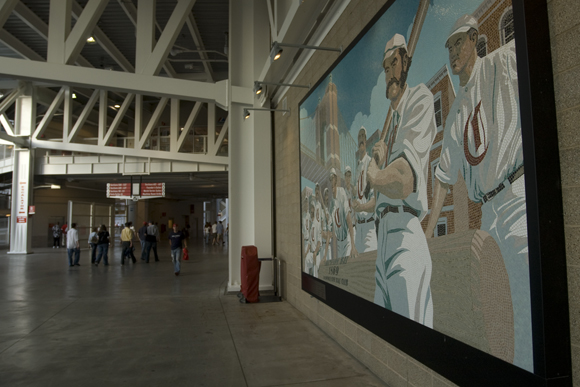
Finally, there’s one more important aspect to the ballpark worth coverage: history. The original Cincinnati Reds were the first professional team (and reviled by many for that at the time, by the way), and the rich history of Reds baseball is infused in the ballpark. The main entrance, Crosley Terrace, is designed to evoke memories of the Reds’ former home, Crosley Field. Statues of former Reds greats Joe Nuxhall, Ted Kluszewski and Ernie Lombardi dominate the area, which is reached after passing through a limestone giant bas relief entitled “Spirit of Baseball.” Past the front gates are two large mosaics honoring the original 1869 Cincinnati Red Stockings and the 1970s Reds of the “Big Red Machine” era. Go out to the children’s play area in the northwest corner of the concourse level and you’ll see historical displays of prior ballparks in Reds history, including the aforementioned Crosley Field, Riverfront Stadium/Cinergy Park and the Palace of Fans. 
In addition, at the end of the 2004 season the Reds opened the Cincinnati Reds Hall of Fame, featuring 16,000 square feet of exhibit space. The museum is open independently of game times, but you’ll definitely want to visit before a game: Admission on non-game days is $8 for adults and $5 for youth, but free before the start of a game if you have a game ticket. (On game days, the hall is open 10 a.m. – 7 p.m. for all afternoon games, and 10 a.m. – 8 p.m. for all evening games. On non-game days, the hall is open Mondays through Saturdays, 10 a.m. to 5 p.m., and on Sunday from noon to 5 p.m.
The displays include a replica of the Palace of the Fans grandstand façade, the Reds’ World Series trophies, a salute to the Big Red Machine of the 1970s complete with life-size bronze statues, a tribute to Cincinnati’s Opening Day tradition of the Findlay Market parade and countless other relics of baseball’s most storied franchise. One of the more unique ways to view Reds memorabilia is in the Baseball Heaven section, set up to look like a rec room from the 1960 (shown above). Though Pete Rose hasn’t been inducted yet into the Reds Hall of Fame, his accomplishments are noted: a special 30-foot-tall wall of 4,256 baseballs marks each of Rose’s record hit total, while visitors can also look outside the Hall to see a “Rose” garden marking the previous outfield spot of Riverfront Stadium where Pete’s record-breaking 4,192nd hit landed.) In addition, an interactive area also lets fans face a 90-mph fastball, pitch from a regulation mound and even scale an outfield wall to take a home run away from an unlucky batter. The tour of Reds history ends with a run through the Reds Hall of Fame Gallery. Membership in the Reds Hall of Fame runs the gamut from the likes of Noodles Hahn and Dummy Hoy from the turn of the century to recent inductees Ken Griffey and George Foster. This was the first hall of fame devoted to a single pro baseball team and well worth an early arrival to the ballpark. 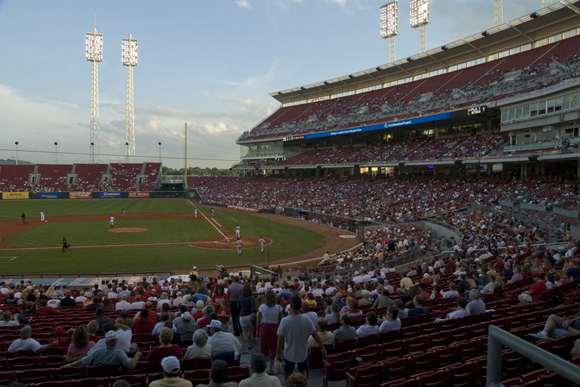
Where to Sit
We sat in virtually every section of the ballpark: club, terrace, mezzanine and bleachers. (OK, we didn’t peruse the really, really expensive Diamond Seats.) The best combination of view and price tag was the Mezzanine Infield area (sections 415-419): you’re relatively close to the action and high enough to see all the action, with a midrange price tag of $19. We’d also recommend either left-field or right-field bleachers; both are inexpensive and ridiculously close to the action. The right-field Sun Deck/Moon Deck seems to have a strong community of regulars, which is always recommended, and the view of downtown Cincinnati is tremendous. In the left-field bleachers, you can’t see the above-average scoreboard, though that’s a plus for many baseball purists.
Concessions
There are 26 concession stands throughout the ballpark with a wide variety of options. Most of the offerings are ballpark staples, but there are two food items worth trying:
Big Red Smokies are the signature hot dog; basically, they’re hot dogs burned to the point where they have a black crust. Now, some of us grew up on burnt hot dogs and find them tasty. Other people hate burnt foods of all sorts.
Montgomery Inn BBQ is served at several stands. Cincinnati isn’t regarded as being a great BBQ city, but Montgomery Inn prepares some top-notch BBQ, and the surroundings are lovely. 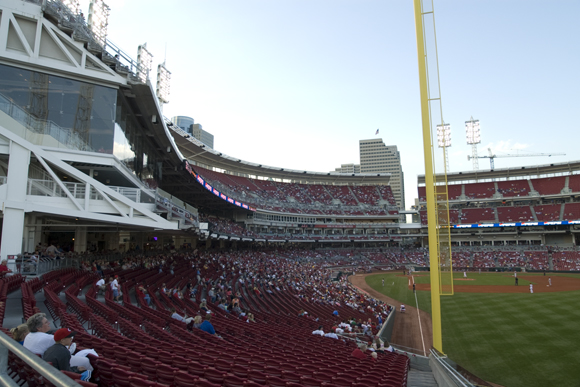
Parking
Great American Ball Park shares some prime riverfront footage with US Bank Arena and Paul Brown Stadium, so there’s plenty of surface parking and ramps within a close walk of the ballpark. You could also park on the Kentucky side of the river and walk across the Southgate Bridge to the ballpark.
For the Kids
Parents may not like it (you can’t see the game while visiting), but there’s a huge play area down the right-field line featuring before-game entertainment, games and other activities.
Where to Stay
For those with a few bucks to splurge, there are some classic and high-end hotels nearby. (Keep in mind that rates at many of these high-end hotels can significantly less expensive on weekends.) The Hilton Cincinnati Netherland Plaza (35 W. 5th St., 513/421-9100) is an Art Deco classic with recently renovated rooms. Another classic downtown hotel is the Cincinnatian Hotel (601 Vine St.; 800-942-9000 or 513-381-3000), built in 1882 as the Palace Hotel and patterned on the Grand Hotels of the 19th century. Eight stories high, the Cincinnatian was regarded as the finest hotel in Cincinnati when built and still has the reputation of offering high-end accommodations. Newer high-end hotels include the Westin Cincinnati (21 E. 5th St., 513/621-7700), which overlooks Fountain Square and is connected to Tower Place Mall; and the Hyatt Regency Cincinnati (151 W. 5th St.; 513/579-1234).
At the midrange is the Millennium Hotel Cincinnati (141 W. 6th St.; 513/352-2100).
For those on a budget, there’s the Terrace Hotel (15 W. 6th St.; 513/381-4000), which seems to suffer from a mixed reputation; and the Four Points by Sheraton Downtown Cincinnati (150 W. 5th St.; 513/357-5800). You can also stay across the river in Covington or Newport, Ky., where your choices include Embassy Suites, Marriott or Comfort Suites.
If staying downtown doesn’t appeal to you, Cincinnati/Northern Kentucky International Airport and its many hotels are just a short freeway drive from the ballpark. 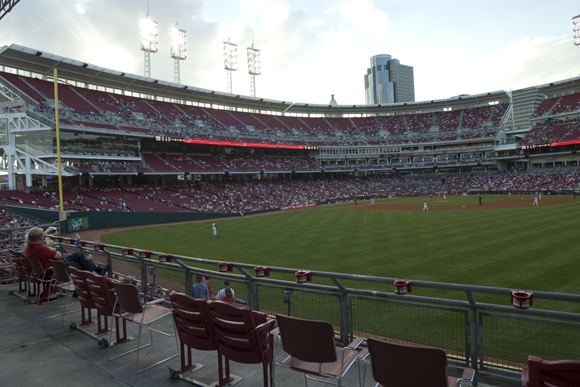
Before/After the Game
There’s a rich heritage of German beer in Cincinnati, and while there’s no remnants of the likes of Hudepohl, Burger and Schoenling in the area (the former Hudepohl-Schoenling brewery is now a Sam Adams brewery), you can find remnants of the German heritage that initially produced the beer culture.
The Hofbräuhaus Newport is across the Ohio River from Great American Ball Park and definitely walkable on a nice day. It’s billed as the first authentic Hofbräuhaus in the United States, featuring beers brewed inhouse and German staples like Sauerbraten, Schweinsbraten and Jägerschnitzel. Zicke, zacke, zicke, zacke, hoi, hoi, hoi!
Not quite within walking distance, but still worth a visit, is Covington’s Mainstrasse Village, which features a wide variety of bars and restaurants (German, French, British and more) as well as shops and such. The city used to host several German beer gardens, and one of the oldest remaining ones is Mecklenburg Gardens (302 E. University Av., Cincinnati; 513/221-5353), dating back to 1865. The menu is standard German fare and some updated items, but the real reason to go is to quaff German beer in an outdoor setting.
And, of course, there’s a mandatory visit to one of Cincinnati’s unique food emporiums. The Reds serve Montgomery Inn BBQ at the ballpark, but the best way to experience it is at one of the three restaurants. The original restaurant (9440 Montgomery Rd., Montgomery) dates back to 1951, while there are newer locations in Cincinnati proper (925 Eastern Avenue) and Fort Mitchell, Kentucky (400 Buttermilk Pike).
Chili is also a passion in Cincinnati, which is the only major city to have multiple local chili chains fighting for business. Cincinnatians throw chili on top of anything — beans, spaghetti, hot dogs, potatoes, burritos, dead cats — and call it haute cuisine. Then again, the chili in Cincy is pretty unique: the flavor is not dominated by chili powder or tomatoes; rather, the flavor tends to be a little on the smoke side, with hints of chocolate and cinnamon. Skyline Chili and Gold Star are two of the leading local chains, although it seems every neighborhood and small town has its own chili house.
